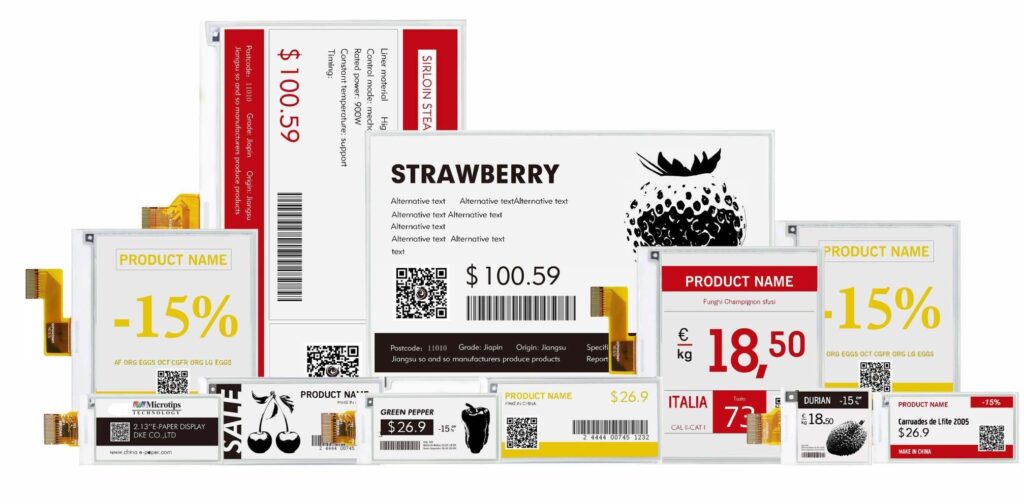
In a world filled with high-resolution LED screens and vibrant OLED displays, a quieter revolution is taking place in the realm of electronic displays. Electronic Paper, or E-Paper, is an innovative technology that offers a refreshing break from the dazzling world of bright screens and backlighting. In this blog, we’ll delve into the fascinating world of E-Paper, exploring its history, technology, and the exciting applications that are driving its adoption.
The Origins of E-Paper
E-Paper, also known as Electronic Ink or E-Ink, is not a new concept. The technology behind it date back to the 1970s when physicist Joseph Jacobson and his team at the Massachusetts Institute of Technology (MIT) began exploring the idea of creating a display technology that could mimic the appearance of ordinary ink on paper.
The result of their efforts was the development of microcapsules filled with tiny electrically charged particles. These capsules could be manipulated to display images and text on a screen, providing a paper-like appearance. The concept was groundbreaking and laid the foundation for what we now know as E-Paper.
How E-Paper Works
E-Paper works on the principle of electrophoresis. It relies on charged pigment particles within tiny microcapsules. These particles are suspended in a clear fluid, and they respond to electrical charges. When an electric field is applied, the particles move to the top or bottom of the microcapsules, making the surface appear dark or light, respectively.
What sets E-Paper apart from traditional LED or OLED displays is that it reflects ambient light just like real paper. This means that E-Paper doesn’t emit light directly, making it much more comfortable for extended reading and less straining on the eyes. Its appearance is also remarkably close to that of printed text on a physical page.
The Advantages of E-Paper
- Low Power Consumption: One of the most significant advantages of E-Paper is its energy efficiency. It consumes power only when the image changes, which means it can display content for extended periods on a single charge. This makes it perfect for e-readers, smartwatches, and other devices that require long battery life.
- Sunlight Readability: E-Paper excels in outdoor settings due to its sunlight readability. In fact, the brighter the ambient light, the clearer the E-Paper display becomes. This makes it an excellent choice for e-readers and digital signage.
- Wide Viewing Angles: E-Paper offers wide viewing angles, much like traditional paper. This means that the display is easily readable from various positions, which is great for sharing content with others.
- Paper-Like Feel: E-Paper’s appearance and texture closely resemble real paper, creating a more natural and comfortable reading experience. This is especially appreciated by avid readers.
- Environmental Friendliness: E-Paper is more environmentally friendly compared to traditional displays, as it consumes less power and doesn’t require constant backlighting, reducing energy consumption.
Applications of E-Paper
E-Paper technology has found its way into various applications beyond e-readers. Here are some of the areas where E-Paper is making a significant impact:
- E-Readers: E-Paper displays are synonymous with e-readers. Devices like the Amazon Kindle and Barnes & Noble Nook use E-Paper screens to provide an experience similar to reading a physical book.
- Digital Signage: E-Paper is being used for digital signage in various settings, including retail stores and public transportation. It offers a dynamic way to display information and advertisements.
- Smartwatches: Some smartwatches incorporate E-Paper displays to extend battery life and improve readability in bright sunlight.
- E-Paper Labels: E-Paper labels are replacing traditional paper labels in the retail industry. These labels can be updated electronically, reducing the need for paper wastage.
- Architecture and Design: E-Paper is used in architecture and design applications for digital blueprints and drawings. It offers a convenient way to work with digital documents while maintaining the feel of traditional paper.
- Art and Fashion: E-Paper technology is gaining traction in the fashion and art world, where designers are using it to create interactive and customizable clothing and accessories.
- Education: E-Paper tablets are being explored as a cost-effective and eco-friendly alternative for students, providing a digital learning platform that mimics the familiarity of textbooks.
Challenges and Future Developments
While E-Paper has come a long way since its inception, there are still some challenges to overcome. The technology’s refresh rate is slower than conventional displays, making it less suitable for fast-moving or multimedia applications. Color E-Paper displays are available but are less vibrant than their LED or OLED counterparts.
Despite these challenges, ongoing research and development are making significant strides in improving E-Paper technology. Faster refresh rates, better color options, and increased flexibility are some areas of active exploration. As technology advances, we can expect E-Paper to become even more versatile and widely adopted.
Conclusion
E-Paper is a remarkable technology that brings the best of both worlds together: the visual appeal of traditional paper and the convenience of digital displays. Its low power consumption, sunlight readability, and paper-like feel make it a promising choice for a wide range of applications, from e-readers to digital signage.
As E-Paper technology continues to evolve, we can look forward to even more innovative uses and improved performance. The future of display technology is not just about dazzling colors and high resolutions; it’s also about the subtle beauty of E-Paper and its capacity to offer a comfortable, eco-friendly, and aesthetically pleasing way to interact with digital content.
Microtips has partnered with an experienced E-paper manufacturer. We represent a full series of E-paper technology, including true color to meet your specific needs. Our exceptional engineering and sales staff follow the complete life cycle of your display products, from designing and pre-engineering to delivering large volume orders and beyond.
